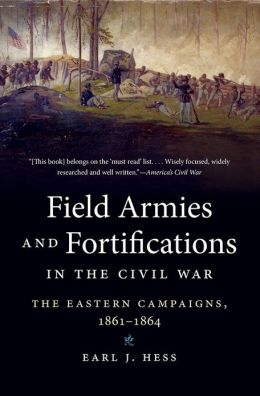Earl J. Hess
2005, 428pp., The University of North Carolina Press, $28.00
ISBN: 978-1-4696-0993-5
Image Courtesy of barnesandnoble.com
When analysis of Civil War battles usually takes place, there are works written about the infantry, cavalry and artillery and their tactical movements around the battlefield. But something rarely talked about are the fortifications and field works made by the armies in order to solidify the position of the armies both Union and Confederate. Earl J. Hess uses this work, Field Armies and Fortifications in the Civil War, to better explain the design, need and uses of the field works on the battlefields and the fortifications all around the coastline. This is the first in a series of books written on the field works during the Civil War.
Earl J. Hess is an associate professor of history at Lincoln Memorial University and has authored other works such as The Civil War in the West: Victory and Defeat from the Appalachians to the Mississippi and Pickett’s Charge – The Last Attack at Gettysburg. His book on Pickett’s Charge was the winner of the 2001 James I. Robertson Jr. Prize from the Civil War Library and Research Center.
Field Armies and Fortifications in the Civil War: The Eastern Campaigns, 1861-1864 is one of the three books Hess has written surrounding field works in the Civil War. Others in the series are Trench Warfare Under Grant and Lee: Field Fortifications in the Overland Campaign and In the Trenches at Petersburg: Field Fortifications and Confederate Defeat. This book about the fortifications during the Eastern Campaigns is a great start to the series, however, as it brings to light certain things which have been ignored or only slightly mentioned in the annals of history. What Hess does in this work is describe in great detail the way in which the field works were built on the field and the problems which the engineers on both sides faced during that endeavor. With the lack of engineers in the army, many times there would be infantrymen creating the field works. This would create works which were not exactly up to par and the men of the ranks would often complain or slowly work because of the hard labor of construction field works. Throughout the text are many examples through drawings, maps or pictures giving the reader a great idea as to what the fortifications looked like through the war. Many times, people tend to think of forts as completely created with stone and embattlements, but sometimes that was just not the case. For example, Hess talks about Federal Fort Sumner and along with his explanation is a picture of the fortification. There is little to the fort, mainly some wood and sandbags placed upon dug embattlements with the cannons placed onto it. This is something which some readers may not be aware of. Another detail which Hess mentions is the fact that at the beginning of the war, Washington only had one fort as part of the defense. If you look at a map of Washington after the war, the entire city is surrounded with forts some of which were quickly built to suppress Early’s attacks in 1864. These attacks are not mentioned in this book since Hess only takes us up to Bristoe Station and the Fall of Plymouth. He does this in order to deal with the field works and fortifications in the Overland and Petersburg in the coming volumes. Nevertheless, this is a welcome addition to any Civil War Library.
I highly recommend this book to anyone interested in the Eastern Campaigns of the Civil War. It gives the readers a better idea of the time it took to create these fortifications and the effect which it had on the battlefield. This work also gives the reader an understanding of how few engineers there were during the beginning of the war and throughout the conflict and the way in which they had to find additional help. This would either end in success or failure and friction between commanders because of it. Field Armies and Fortifications in the Civil War: The Eastern Campaign, 1861-8164 is a welcome addition to any Civil War library and to the academia of the conflict.

 RSS Feed
RSS Feed
